If you enjoy Italian Bread, but want to give it a slightly different flair, try these Italian Spelt Loaves. Instead of using regular bread flour, the biga and final dough are made with a mixture of white and whole grain Spelt flour.
The method for making this bread is similar to the method we used for the Italian Bread in the BBA Challenge; however, this bread is made with Spelt instead of regular bread flour and the percentage of biga to dough is lower than the one we made in the BBA Challenge. The biga performs best when you make it the day ahead and place it in the refrigerator to ferment overnight.
This is a pretty healthy bread, and the dough is very versatile. You can make loaves, rounds, torpedo rolls, pizza, focaccia, bruschetta, calzones, and breadsticks using this basic dough.
Italian Spelt Loaves
Adapted from: Spelt Healthy! by Marsha Cosentino, M.A.
Making the All-Purpose Biga
This recipe makes about 2 cups (14 oz/375 g) of biga.
Ingredients:
- 1/4 tsp instant yeast
- 1 cup/227 grams lukewarm water (divided 3/4, 1/4)
- 1 1/2 cups/200 grams white spelt flour (divided 1, 1/2)
- 1 cup/130 grams whole grain spelt flour (I used home-milled spelt flour)
Steps:
- In a large bowl, stir together 1 cup of white spelt flour, 1 cup of whole grain spelt flour and the yeast.
- Pour in 3/4 cup of water and mix well.
- The biga will be thick to begin with (Photo #2) but will soften and become lively while it sits on the counter.
- Cover it with plastic wrap and let it stand for 4 hours at room temperature (75 degrees F). The biga is pretty active after 4 hours. (photo #3 below)
- Stir in the additional 1/2 cup of White Spelt flour and 1/4 cup water.
- Let the biga stand at room temperature for another hour or so until it becomes active and bubby.
- Use the biga at the end of the 5-6 hour proof or refrigerate it overnight to use the next day. If you refrigerate it overnight, just be sure to give it time to warm up to room temperature to get the fermentation activity going again.
- I placed mine in the refrigerator overnight. Photo #4 below shows what it looked like after warming up to room temperature the next day.
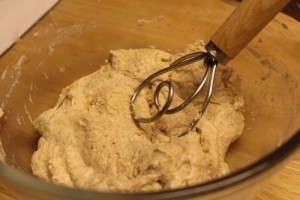 |
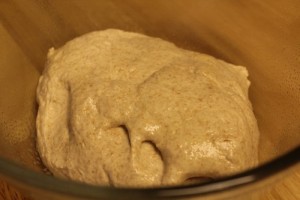 |
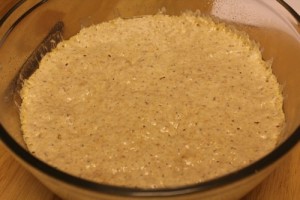 |
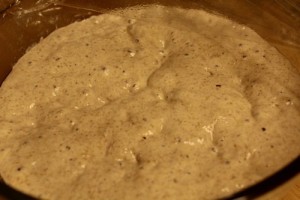 |
Making the All-Purpose Italian Dough
Makes: 2 loaves
Ingredients:
- 2 cups/375 grams biga
- 1 1/2 tsp instant yeast
- 1 1/2 cups/341 grams water (divided 1 1/4, 1/4)
- 2 tsp salt
- 1 cup/130 grams whole grain spelt flour
- 3 1/4 to 4 cups/423 – 520 grams white spelt flour (this will vary with the type of white spelt flour you use. I used a scant 3 1/4 cups)
Steps:
- Place the biga in a large mixing bowl and pour in 1 1/4 cups of water. Mix vigorously.
- In a separate bowl, stir together the whole grain flour, 2 cups of white spelt flour and the yeast.
- Add the dry ingredients to the wet ingredients and mix to form a rough dough.
- Add the salt to the remaining 1/4 cup of water and stir then add it to the bowl.
- Gradually add 1 1/4 to 1 1/2 cups of the white flour and beat or stir with a Danish Dough whisk until it forms a soft dough. Adjust the consistency if necessary by adding White Spelt flour by the tablespoon.
- Scrape down the sides of the bowl and mix until the dough forms a ball. The dough will be sticky, soft and very moist at this point.
- Turn the dough out onto a surface lightly floured with White Spelt flour. Cover it and let it rest 10 minutes
- Form the dough into a loose ball, knead it briefly by hand until it is elastic but still slightly tacky.
- Place the dough in a lightly oiled bowl. Cover and let the dough rise in a draft-free place at cool room temperature (70 – 75 degrees F) for about 40 – 50 minutes.
- Check the dough and if an impression remains when a finger is pressed gently into it, then it is ready.
- Ease the dough from the sides of the bowl and fold it over the top using a plastic spatula.
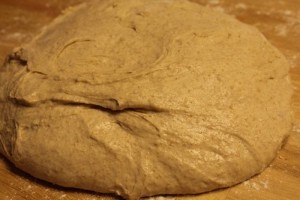 |
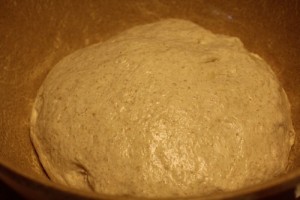 |
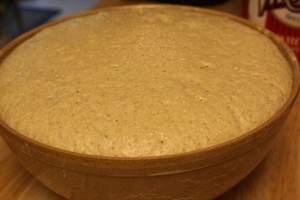 |
 |
- Gently deflate the dough using your fist, but don’t press down hard or punch it. You don’t want to expel the gases. It should be springy at this stage.
- Remove the dough from the bowl and divide it into two pieces.
- Shape the pieces into rough balls and let them rest seam side up, covered with plastic wrap on the counter for 10 minutes before shaping.
- Shape the balls into torpedo-shaped rolls and place onto parchment paper.
- For assistance in shaping the rolls, refer to the shaping section in the Five Grain Sourdough with Rye Sourdough post.
- Preheat the oven to 425 degrees F. with a baking stone on the middle rack and a steam pan underneath.
- Sprinkle the tops of the loaves lightly with White Spelt flour and cover loosely with plastic wrap. I sprayed the loaves with olive oil instead of using more flour.
- Let the loaves rise until doubled in size. This should take about 15 – 20 minutes.
- During the last 5 minutes of the rise, score the loaves using a lame or serrated knife. Make 2” long, 1/4” deep slashes along the tops of the rolls.
- When the oven is ready, slide the rolls (and the parchment paper) onto the preheated baking stone and pour hot water into the steam pan.
- Spritz the walls of the oven several times during the first 3 minutes of baking.
- Bake the loaves for 15 – 20 minutes or until they reach a deep golden brown color.
- The loaves should sound hollow when thumped on the bottom.
- Remove the loaves to a wire rack to cool completely before slicing and serving.
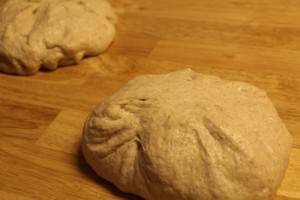 |
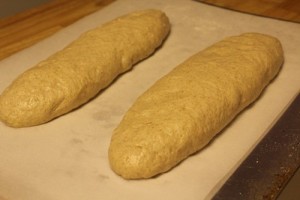 |
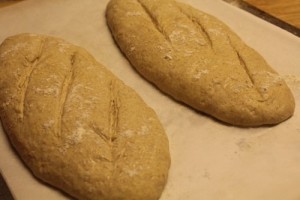 |
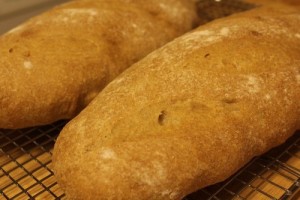 |
Slice and enjoy! These loaves taste really good dipped in olive oil and herbs. I also enjoyed them with jam. They do tend to get dry fairly quickly since they don’t contain any fat in them.
Happy Baking!
Cathy
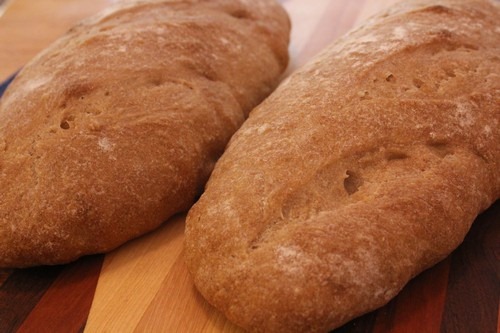
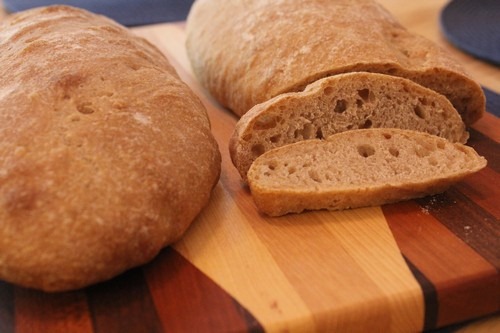
theoldmancunian says
Can any biga that’s left over be stored in the refrigerator for any length of time?
Cathy (breadexperience) says
Yes, you can store leftover biga in the refrigerator, usually for a few days.
revoltofthebarbarians says
Thank you for all the amazing recipes. I was wanting to try this with 100% home-ground whole wheat spelt. Do you think any adjustments would have to be made?
Cathy Warner says
Hello, You can certainly try it with the whole grain spelt, but it will be a heavier/denser dough and will probably need a little more water. I would recommend sifting some of the milled whole wheat spelt to remove some of the bran and germ so that you get a lighter flour.
Let me know how it goes.
Anonymous says
I have a Bosch Mixer with a dough blade. I have made whole grain spelt bread (I grind the grain.) I let the mixer run for 4 min, wheat bread takes 10 min. My question is What is the purpose of the biga?
Is it for flavor? Is it to help develop the gluten?
Cathy Warner says
Hello, Thanks for visiting the Bread Experience. I apologize for the delay in responding. I’ve been out of the country with limited access to the Internet.
The purpose of the biga is to develop the flavor. Allowing part of the dough to ferment in the refrigerator overnight will give the bread more complex flavor than just using the straight dough method.
Happy Baking!
Cathy
Zella Vella says
Sounds delicious
Nicole says
I mill my own spelt flour too! How much does your cup of white spelt and whole spelt flour weigh? I find weights to be better measure than volume, especially since freshly ground flour is so fluffy. I’m looking forward to trying your recipe!
Cathy says
Hi Nicole, I utilize weight measurements as well. However, this particular recipe utilized volume measurements. I typically use Vita Spelt AP flour. You can convert the volume to weight measurements using an online conversation calculator. I would start with the lower amount of flour and only add more if necessary. I do hope you enjoy it!
Nicole says
Thanks! I’ve made this recipe a couple times now, and love it. I made a test pizza crust with part of a batch, baked on a hot stone (500) which turned out wonderfully as well. I bought your referenced book, “Spelt Healthy,” too. In the book, she says whole grain spelt weighs 5 oz per cup. White spelt varies by manufacturer from 4.35 to up to 5 oz a cup, average is 4.5. I weighed my own fluffed, scooped, and leveled white spelt cups, and they vary between 4.25 to 4.65, so your advice to use less, and add later, is sound! I especially appreciate the photos in your blog (not in the book.) It helped to visually check my results with yours at the various stages. Thank you for the inspiration to try spelt in new and delicious ways!
Cathy says
Thanks for the feedback Nicole! Glad you found my advice sound. “Spelt Healthy” is a very helpful reference book.
Genet says
Can this be made with sourdough starter (spelt) instead of the yeast ?
Would you have any idea how to do that ?
Thanks !
Cathy says
Hi Genet, you could try using about 20% starter in the biga and let it rest at room temperature overnight rather than placing it the refrigerator. 20% of the flour weight would be about 66 grams of starter in the biga. It will be a stiffer levain. You probably won’t need any starter in the final dough.